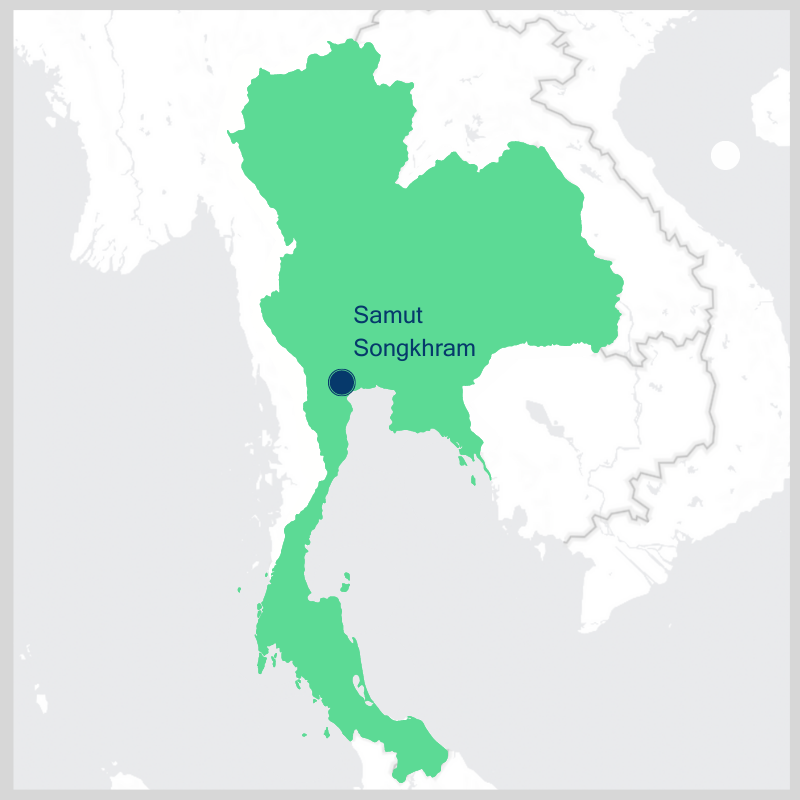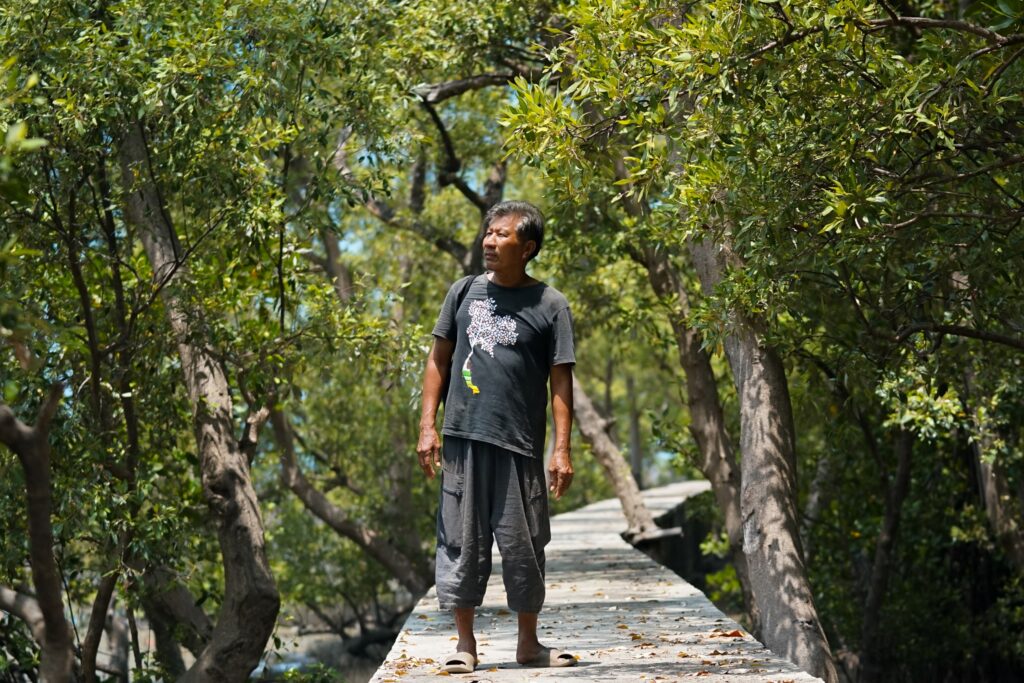SAMUT SONGKHARM, THAILAND – To battle rising sea levels, local communities in Thailand’s Samut Songkhram province have found ways to reduce coastal erosion and share disaster-warning data.
Looking seaward from the Mangrove Nature School in Bang Kaeo subdistrict in Thailand’s Samut Songkhram province, the view features walls of bamboo stakes stretching nearly two kilometers along the coastline.
These walls were first made by villagers 16 years ago as an experiment – they were looking for a way to prevent coastal areas being eroded by strong waves.
Villagers pushed several thousand bamboo stakes into the muddy ground, creating rows of natural seawalls that reduced the force of the waves.
The porous walls also helped retain the mud along the coastal flats, which helps maintain the habitat of mangrove forests while allowing the water to seep in and nurture the trees replanted behind the walls.

The mudflat area soon regrew, offering space to replant more mangrove trees as a long-term solution to fighting coastal erosion and storm surges, partly caused by the rise in sea levels.
“At first, mangrove reforestation was just a communal activity and only local people volunteered to grow the trees and look after them,” said Wisut Nuamsiri, a leader of the Bang Kaew Mangrove Forest Conservation Group made up of the villagers who initiated the bamboo seawalls initiative.
“But bit by bit, our initiative has been noticed and grown further. We are now supporting businesses that bring in people to plant trees here as part of their CSR [Corporate Social Responsibility] campaigns.”

The local community has developed a business model to help these campaigns by offering CSR packages to companies.
Villagers are in charge of organizing mangrove reforestation events, including preparing young trees and plants and identifying suitable areas to grow them. They look after the trees when the visitors return home, ensuring the trees’ chances of survival.
The local community built the Mangrove Nature School in the mangrove forest they replanted, which has become a tourist attraction as well as an education center.
The school is a small wooden building surrounded by mangrove trees. On one wall hangs notice boards with information about the mangroves and the reforestation efforts.
There is a long, elevated walking trail to take visitors from the school building through the mangrove forest to the open sea, where they can see the bamboo walls sitting in the mud.
Learning from mistakes
The idea of using bamboo stakes to create the seawall came after learning from earlier mistakes.
Samut Songkhram is among the low-lying provinces most affected by coastal erosion in the upper Gulf of Thailand, known as the Bay of Bangkok. Thailand’s Department of Marine and Coastal Resources estimated that up to five meters of land had been lost to the sea each year.
This threat prompted authorities to build concrete seawalls along the coast, but those walls have wiped out many coastal mudflats that hosted mangrove forests and animal habitats.
With solid walls, the force of the waves is diverted to the areas beyond the concrete structure and causes severe erosion – requiring the never-ending construction of new sea walls.
“Three decades ago, the entire shoreline of the Bay of Bangkok was covered with thick patches of mangrove forests, acting as a natural barrier and protecting the villages from storms and waves,” said Wisut, who grew up in Samut Songkhram.
“We’ve lost most of the existing mangrove forests now as they were mainly cleared to make way for shrimp farms.”

However, mangrove reforestation alone may not save Samut Songkhram and Thailand’s coastal communities from rising sea levels, which are forecast to be more severe if no urgent measures are taken to limit global temperatures.
Seri Suparatit, the director of the Center for Climate Change and Disasters at Thailand’s Rangsit University, has studied the impacts of sea level rises in the Chao Phraya River Basin, which is connected to the Bay of Bangkok.
In a business-as-usual scenario, his model shows that rising sea levels will gradually erode the coast, with saltwater making its way inland up to two, five, eight and 20 kilometers by 2030, 2050, 2070 and 2100 respectively.
His study projects increasing rainfall in the basin delta, causing widespread flooding for up to two months per year.
“As the threats from climate change will worsen, Thailand needs to focus on climate adaptation, especially and preferably with nature-based solutions that help us survive in the ever-hotter world,” said Seri.
He added that the adaptation measures must emphasize a live-with-water approach, by redesigning cities to make more room for water.

Localizing adaptation plans
In 1997, communities along the Bay of Bangkok were hit by tropical storm Linda. However, the disaster warning system in Thailand at that time was not advanced enough to keep people fully informed so they could prepare and prevent any damage.
Bandit Pansawat, now 47, was a youth when the storm hit his home in Samut Songkhram. He remembers vividly how fear surged through his community.
“Twenty-five years passed and there is still a gap in the emergency warning system. When a storm surge happened in our province two years ago, the official warning system could not reach the majority of local people,” said Bandit, who chairs the Samut Songkhram Amateur Radio Association.
To close that gap, he turned his hobby into a solution – using ham radio to communicate with others and spread the word.

He started an emergency warning and response network among more than 100 amateur radio operators, which allowed an information exchange about disasters such as floods and storm surges.
“If our members notice emergency incidents or disasters, they will share information across our ham radio group. We will then dispatch team members, who have been trained in emergency response, to the affected areas to help people and assist local authorities,” he explained.
“Radio frequencies are more resilient in an emergency situation, when the cellphone network may be unusable from infrastructural damage, or many people try to dial simultaneously.”
They also share information on social media, including the Samut Songkhram Self-Management Facebook group, administrated by Bandit. His group members rehearse emergency response drills three times a year to keep them well-prepared for emergency situations.
Their efforts showcase the crucial role of individuals and local communities in bottom-up climate adaptation strategy, which Chainarong Setthachua from the Faculty of Humanities and Social Sciences at Mahasarakham University believes should be integrated into the national climate plan.
“Local communities should play a role in localizing emergency response and management plans that suit them the most,” he suggested.
“Their participation is essential to overcome the challenges posed by the climate crisis.”
Supported by the Internews’ Earth Journalism Network, this story is part of a series on the impact of rising sea levels in the Bay of Bangkok and local initiatives to create resilience. Find the first story that explores the multiple impacts of sea level rises in Samut Songkhram here.
Visarut Sankham is a visual storyteller and documentary photographer based in Chiang Mai, Thailand.






